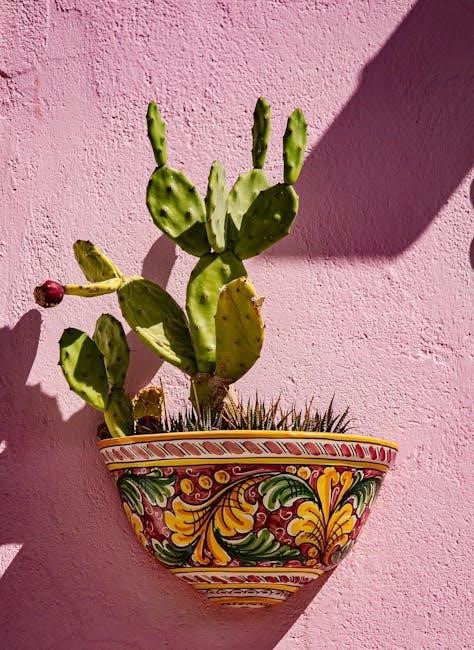
cactus guide
Discovering the world of cacti is exciting with a comprehensive guide, using
tags
to navigate and learn about these unique plants, providing essential information and tips for successful growth and care, in a clear and concise manner always.
General Information About Cacti
Cacti are fascinating plants that have adapted to survive in harsh environments, with unique characteristics that set them apart from other plants. They come in a wide range of shapes, sizes, and colors, making them a popular choice for gardeners and plant enthusiasts.
Using
- ordered lists
and
- unordered lists
can help to organize and present information about cacti in a clear and concise manner.
Cacti have been a part of human culture for thousands of years, with many species being used for food, medicine, and other purposes.
Understanding the general information about cacti is essential for anyone looking to learn more about these incredible plants, and can be achieved by reading about their history, classification, and uses.
With over a thousand different species of cacti, there is always something new to learn and discover about these amazing plants, and using
paragraphs
and
headings
can help to make this information more accessible and engaging.
By exploring the world of cacti, people can gain a deeper appreciation for the natural world and the incredible diversity of plant life that exists on our planet.
Feeding Schedule for Indoor Cacti
Creating a feeding schedule for indoor cacti is crucial for their growth and survival, and can be achieved by using a
to organize and track the different types of fertilizer and the frequency of application.
During the summer months, cacti-specific fertilizer can be used to provide the necessary nutrients for growth, and standard fertilizer can also be effective, but may not provide the same targeted care.
Using images and
A well-planned feeding schedule can help to ensure that indoor cacti receive the necessary nutrients to thrive, and can be adjusted according to the specific needs of each plant.
By following a feeding schedule and using the right type of fertilizer, indoor cacti can be kept healthy and thriving, and can be enjoyed for their unique beauty and low-maintenance requirements, making them a great addition to any home or office, with the help of
and spans.

Care Strategies for Cacti
Effective care strategies for cacti involve using
and sections to organize tips and advice for optimal growth and maintenance always.
Light Requirements for Cacti
When it comes to light requirements for cacti, it is essential to provide them with the right amount of sunlight to thrive. Using a combination of natural light and artificial light can be beneficial for cacti growth. Most cacti species require bright, indirect light to photosynthesize and grow. Placing cacti near a
or under skylights can provide the necessary light for optimal growth; However, it is crucial to avoid direct sunlight, which can cause
burning
or
scorching
of the plant. Using a
can help determine the right amount of light for your cacti. By providing the correct light requirements, you can help your cacti grow healthy and strong, with vibrant colors and textures. With proper light, cacti can flourish and become a beautiful addition to any room, making them a great choice for indoor gardening.
Water Requirements for Cacti
Watering cacti requires careful attention to detail, as overwatering can be detrimental to the plant’s health. Using a
can help prevent waterlogged soil, reducing the risk of
root rot
. It is essential to water cacti sparingly, allowing the soil to dry out completely between waterings. The frequency of watering depends on the climate and time of year, with more frequent watering required during the summer months. A
with a long spout can help deliver water directly to the soil, reducing the risk of
overwatering
. By watering cacti correctly, you can help prevent common problems such as
soft spots
and
discoloration
. With the right watering technique, cacti can thrive, producing vibrant flowers and stems. Proper watering is crucial for maintaining the overall health and appearance of cacti, making them a low-maintenance addition to any indoor space. Regular monitoring of the soil moisture can help ensure the optimal watering schedule for your cacti.

Types of Cacti
Exploring the diverse range of cacti using
and classification systems to identify and learn about different species always.
Prickly Pear Cactus
The Prickly Pear Cactus, also known as Opuntia, is a unique and fascinating plant, with a section on
and characteristics that set it apart from other cacti species, including its round, segmented components and ability to grow in a bushlike form.
This type of cactus is commonly found in dry, desert-like environments and is known for its ability to thrive in conditions with limited water and nutrients, making it a popular choice for gardeners and plant enthusiasts, using
- ordered lists
to outline its benefits and
- unordered lists
to describe its features.
The Prickly Pear Cactus is also relatively low-maintenance, making it a great choice for those new to cactus care, and its potential for growth and development is significant, with some species producing vibrant flowers and fruits, as shown in the image section, which is not included here.
Overall, the Prickly Pear Cactus is a remarkable plant that offers many benefits and opportunities for growth and exploration, using
paragraphs
and
to organize and present information, with a total of .
Other Types of Cacti
There are numerous other types of cacti beyond the Prickly Pear, including the Thanksgiving cactus, Christmas cactus, and Easter cactus, which are discussed in the context of holiday cacti and their unique characteristics, such as flowering habits and growth patterns, using
to compare and contrast their features.
These cacti are known for their ability to thrive in indoor environments and are often used as ornamental plants, with a focus on
their care and maintenance requirements, including lighting, watering, and fertilization, as outlined in the
- definition lists
and
- unordered lists
that provide detailed information on their needs.
Other types of cacti, such as the Saguaro and the Barrel cactus, are also popular among cactus enthusiasts, and are often sought after for their unique shapes and sizes, as shown in the
captions and
With over a thousand different species of cacti, there is a wide range of diversity and complexity, making the world of cacti a fascinating and rewarding area of study, using sections and
to explore and present information, with a total of , and including
and to organize the content.
Leave a Reply
You must be logged in to post a comment.